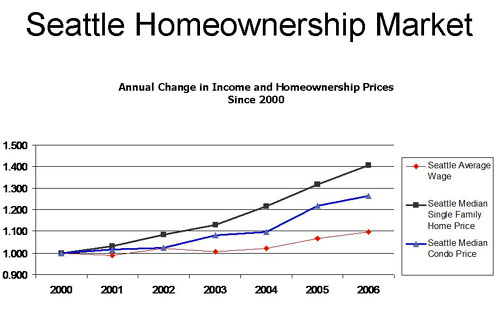
Surveys
DJC.COM
December 7, 2007
Workforce housing shortage is a ‘silent epidemic’
Lorig

Ferris
|
Imagine you are a schoolteacher, firefighter, police officer, health-care worker, retail clerk or any other median-income worker whose job is essential to the economic vitality of our cities. If you work in Seattle, chances are you don’t live there. And in cities across our state, this is becoming an all-too-common scenario, one with major environmental and social impacts, including lengthy and pollution-inducing commutes, sprawl development and the disenfranchisement of people from the communities in which they work.
In major cities nationwide, housing prices are increasing at a much faster rate than incomes, making it difficult for middle-income families to rent, let alone buy, a home in the city. In King County, for example, the median wage has increased on average of 2 percent a year for the last five years, while at the same time the median price for a single-family home has increased from $300,000 to $500,000 — 10 percent a year. The rates for condominiums and apartments are slower, but still prohibitive, with condo prices increasing an average of 7 percent a year and apartment rents increasing 6-8 percent for the last few years.
Today, fewer than half of Seattle’s workers live in the city. Senator Patty Murray calls this lack of affordable housing a “silent epidemic.”
Why should we care?

Image courtesy of Mithun Architects Lorig and the King County Library System are planning a joint development in Newcastle consisting of a new library, retail and a mix of housing that includes some affordable units. |
The lack of affordable housing contributes to environmentally unsound development where people live far away from city centers. Forcing so many people out of the local market and into sprawl developments results in increased traffic congestion, air pollution and environmental degradation. It also puts a strain on public funds and infrastructure, requiring the construction of new roads, schools, libraries and other community services for this relocated population.
The shortage of such housing is an economic development issue as well. Many corporations make the decision about where to locate a branch office based on whether employees can obtain decent, safe and affordable housing. Employers that do have a significant number of workers commuting long distances often have a greater problem with decreased worker productivity due to the personal hardships and stress such commutes can create.
Akin to the infamous words of the Apollo 13 astronauts: “Washington, we have a problem.” We need to stimulate the creation of more affordable housing.
One particularly sensible solution to the problem is workforce housing, a segment of affordable housing that is gaining traction, fueled by the recognition that an economically diverse population is integral to a city’s economic health and vitality. Key factors that define workforce housing are that it is affordable to the critical workforce — teachers, firefighters, police officers, nurses and other middle-income workers — and is located near major employment centers.
Meeting the demand
| Workforce housing resource organizations |
|
ARCH — A Regional Coalition for Housing A collective of 16 jurisdictions on the Eastside working to preserve and increase the supply of housing for low- and moderate-income families by providing technical assistance, pooling resources to stimulate investment and promoting community engagement. http://www.archhousing.org Housing Development Consortium A nonprofit trade association in Seattle and King County that offers technical and policy expertise, facilitates public awareness and education programs, and brings together nonprofit developers and others to develop and preserve low- and moderate-income housing. http://www.housingconsortium.org Middle Income Housing Alliance A broad-based campaign to build public and political support for practical, market driven, public and private housing strategies that will keep Seattle’s economy strong by retaining a qualified workforce and discouraging further sprawl and congestion. E-mail: croyer@theroyergroup.com Puget Sound Regional Council Prosperity Partnership A coalition of more than 250 government, business, labor and community organizations from King, Kitsap, Pierce and Snohomish counties dedicated to developing and implementing a common economic strategy. http://www.prosperitypartnership.org Seattle Office of Housing The city of Seattle department responsible for helping stimulate housing development so that there is a full range of housing choices and opportunities to serve our diverse community. It also helps fund affordable workforce housing and supportive housing that enables vulnerable people to achieve stability and move along a path toward self-sufficiency. http://www.seattle.gov/housing Seattle Urban Land Institute A membership-based organization providing leadership, research and resources to promote the responsible use of land and create and sustain thriving communities. http://www.seattle.uli.org |
Just as everyone is affected by the shortage of workforce housing, everyone can be part of the solution to address this imbalance.
Without question there is a huge unmet demand for workforce housing. There is, however, some reluctance on the part of the building industry to embrace it due to the impression that it is not financially attractive. On the contrary, while workforce housing may not have the same immediate returns of some higher-end home developments, it can definitely pencil out financially over the long-term.
Lenders and investors are starting to recognize this too. Because of the overwhelming demand there is less risk, so lenders and investors are becoming more apt to finance a project if it includes workforce housing.
The good news is we have the tools available for policymakers, developers and employers to increase the supply of workforce housing in cities. Tools such as tax exemptions and incentive zoning are ready for use and do not require new tax revenues.
Earlier this year, the state of Washington expanded the multifamily tax exemption to stimulate the production of affordable housing. Now even smaller cities such as Newcastle and Mercer Island can adopt policies to spur economic development in their urban centers and ensure a portion of new housing is affordable for the middle-income workforce.
Cities also can use zoning and land-use incentives to encourage the development of affordable housing. The city of Seattle is reviewing proposed policy changes to encourage developers to provide affordable housing in exchange for increased height and density. Other workforce housing incentives include reducing parking requirements in areas well served by transit or allowing accessory dwelling units in single-family neighborhoods.
In addition, public-service projects such as libraries, community centers, fire stations, light-rail stations and park-and-ride lots can be developed jointly with housing that is affordable to the workforce, resulting in increased economic value to the public-service provider and the city in which the project is located.
The city of Newcastle is taking advantage of these tools and recently passed a resolution enabling a joint development project between the King County Library System and Lorig. Pending final approval by the library board, the project will be a mixed-use development that includes a new library, retail and housing — of which 10 percent will be affordable. This project uses many of the tools available now, including increased height and density, reduced parking requirements and a short-term property-tax exemption in return for creating permanent affordable housing.
Instead of a stand-alone library with no financial returns, the resulting mixed-use development will increase the value of the land by $1 million for the King County Library System and increase revenues to the city by more than $800,000 through sales and property taxes on the construction, retail and future improvements. It will be the first project created under Newcastle’s new downtown urban plan.
Resources to realize the vision
To help policymakers, developers and businesses understand and use these tools, there are a number of organizations that can serve as resources. The list includes the Puget Sound Regional Council, Urban Land Institute, Seattle Office of Housing, ARCH — A Regional Coalition to Create Housing, the Housing Development Consortium and Middle Income Housing Alliance. Each group shares the common mission of increasing the production of affordable housing and building a sustainable future.
With projected strong economic growth and the concentration of jobs in major city centers, we are likely to see an even greater push for affordable housing. As we look to the future 10, 20 or 30 years from now, what kind of community do we want? Will our urban neighborhoods include the teachers, police officers and firefighters that serve our community? Or will the people that work in these critical fields be commuting even longer distances to get to and from work?
If we want a future in which middle-income families are an integral part of the cities in which they serve, we all can help by encouraging our city councils and county representatives to adopt the tools as well as create new mechanisms to increase the production of workforce housing. As developers, we can make smart choices and commit to integrate affordable housing into projects. And as business leaders and major employers of the critical workforce, we can support policies and practices that promote choice and opportunity for middle-income citizens who are core to the livability and vibrancy of our cities.

Graph courtesy of the Seattle Office of Housing
Median prices for Seattle homes have been increasing much faster than average wages.
|
Hal Ferris is a principal with Lorig, a Seattle-based real estate development and management company specializing in housing, mixed-use and retail developments. He is an advocate for workforce housing, serving as co-chair of the Seattle Urban Land Institute’s Workforce Housing Committee, a member of the Puget Sound Regional Council’s Prosperity Partnership Workforce Housing Task Force and a member of the Bellevue Planning Commission.
Other Stories:
- Commercial real estate continues its strength
- Retail evolves in mixed-use projects
- Use cost segregation to cut Uncle Sam’s bite
- Too many condos in Seattle? Think again
- An urban village emerges on Seattle’s First Hill
- Pros and cons of the Industrial Jobs Initiative
- What’s next for Seattle’s CBD office market?
- Developing retail? Here are some things to know
- Downtown becomes too pricey for disabled homeless
- Now is the time for apartments — but beware!
- Will good times continue for our market?
- Full speed ahead as CBA turns 30
- CBA Insights speaker profile: Dennis Wilde
- CBA Insights speaker profile: John Parker
- CBA Insights speaker profile: Linda Berman
- Hot Eastside office market won’t get red hot
Copyright ©2009 Seattle Daily Journal and DJC.COM.
Comments? Questions? Contact us.